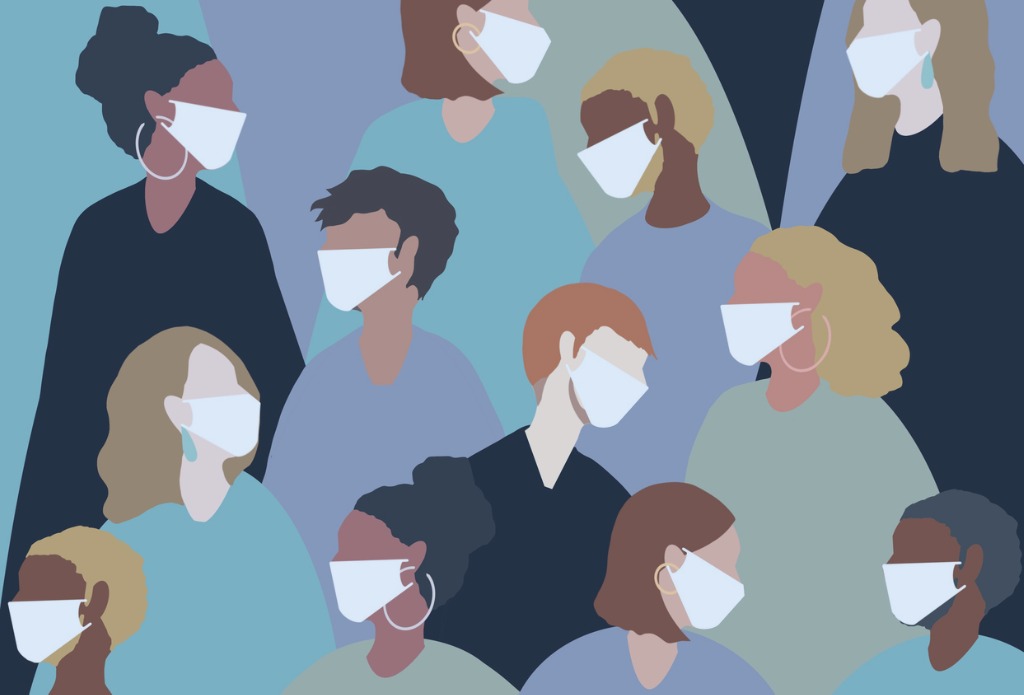Competing Benefits: Economic Theory and COVID Constraints

Those who consider themselves healthy will be more willing to comply with COVID restrictions if they believe, according to their own estimations, that the expected losses from the disease will be significant, suggest researchers of the Faculty of Economic Sciences at HSE University.
Based on the classic Prisoner’s Dilemma, HSE researchers modeled human behavior strategies in the face of COVID restrictions. Their model showed that unequal access to medical care both contributes to irresponsible behavior in some citizens and the independent acceptance of restrictions by others, without any government intervention. The study was published in the journal Public Administration Issues.
During the first wave of infections of the coronavirus pandemic, government decisions were often made at random, based on common sense or epidemiological calculations. Very quickly, implemented measures came into conflict with societal ideas of efficiency and fairness—i.e., economic issues. Meanwhile, simple classical models that economists usually use in their studies can tell a lot about the motives behind citizens’ behavior when restrictions are implemented, and about possible options for public policy.
One of the most famous models in game theory is the Prisoner’s Dilemma. Two people caught while trying to escape are faced with a choice: to be silent or betray the other? Neither of them knows how the other will act. Both face punishment in the form of an additional term of imprisonment, but its severity depends on how the captured fugitives behave. If one of them testifies against the other, his term will be shortened, and the term of the silent fugitive will be as severe as possible. If both testify against each other, then both will be punished with serious sentences. If both are silent, then each prisoner’s punishment will be mild. The benefits of cooperation outweigh the benefits of pursuing one’s own interests. Despite this, people do not always agree to mutually beneficial cooperation due to imperfect information.
In the case of pandemic-related restrictions, the logic remains: for example, if everyone voluntarily self-isolates at home, then one person who violates the restriction wins, since they will not get infected and, moreover, retain their usual lifestyle. But, if everyone starts to ignore the restrictions, the increase in the rate of infection leads to a worsening of the situation for everyone (at the very least due to the decrease in the availability of medical care).
However, restrictive measures do not always find support among populations. In a lockdown, even vulnerable citizens (‘at-risk groups’) will be inclined to violate the bans if they consider freedom of movement important and are confident that they will receive adequate medical care. Individuals who suffer large losses under restrictive measures (quarantine, self-isolation, or bans on work or movement) and, at the same time, have high incomes and access to high-quality health services, will be willing to accept the risks of infection, even if their behavior results in an escalation of the epidemic. Only when citizens consider the likelihood of their receiving quality assistance to be low do they consider following restrictions to be more advantageous.

Alexey Kalinin,
first author of the study and Associate Professor of the Faculty of Economic Sciences at HSE University
‘Together with my colleagues Ludmila Zasimova, Marina Kolosnitsyna, and Natalia Khorkina, we consistently modeled situations in which all people support or, conversely, violate the imposed restrictions. If there is a significant lack of equal access to medical care in a given state, this can contribute not only to irresponsible behavior among some citizens, but also to the ready acceptance of restrictions by other citizens, without any government intervention.’
Convincing at-risk groups for whom the probability of becoming infected is close to 1 or those who are currently sick to stay home is pointless, the researchers say. The disease is already embedded in their behavior. But there is a clear rationale for conducting information campaigns aimed at healthy populations to convince people of the risk of infection: those who consider themselves healthy will be more willing to comply with restrictions if, according to their own estimations, the expected losses from the disease are significant.
In addition to analyzing individuals’ behavior, the HSE researchers examined the model’s results in terms of the welfare of society as a whole.
From the standpoint of utilitarianism, that is, maximizing total social welfare, it turns out that the general acceptance of restrictions (all forms of lockdowns) is not advantageous. If there is a sufficiently effective way to distinguish a carrier of the disease from a healthy person, then from the point of view of society, it is enough to isolate only one group, and it does not matter which one. This is what happens in the case of local quarantine bans: if it is known that a certain group is sick or at higher risk, it is sufficient to isolate that group without introducing bans for society as a whole.
At the same time, such an approach does not at all guarantee that partial or even more general restrictions will be better for society than abandoning them, which led to epidemic. This situation develops when the total loss of welfare from restrictions is estimated to be higher than the total damage from the massive spread of infection. This explains the rationality of the decisions of individual states that abandoned the policy of prohibitions as such, as well as the conscious acceptance of epidemics with low mortality—as in the case of seasonal ARVI diseases. This was done, for example, by Sweden (in the first wave of the pandemic), Japan, and South Korea, whose restrictions were advisory in nature.
An alternative approach to public welfare is the Rawlsian approach, where the welfare of the worst-off individuals is important. It unexpectedly leads to a situation where it is beneficial for the state to impose restrictions on the healthy, and not the sick or vulnerable population (which already ‘will find a way’ to get sick and suffer losses from illness in addition to losses from isolation). The fact that in practice, instead of this approach, general bans are chosen is explained by the impossibility of separating sick and healthy individuals with perfect accuracy: it is more effective to isolate everyone rather than to allow a sharp deterioration in the situation of at least one person.
‘In general, the desire for maximum, complete isolation of all groups of the population from the standpoint of social welfare and the effectiveness of public administration turns out to be untenable,’ says Kalinin. ‘The main issue is whether the restrictions applied in order to divide society into groups that are as isolated and homogeneous as possible are sufficient to prevent direct contact between them (simultaneously being on the street or in public places). A similar approach was used, for example, at the beginning of the epidemic in the Netherlands, where isolation requirements were aimed at the high-risk group—the elderly—and no formal restrictions were introduced for other groups of the population.’
In the absence of reliable quantitative information about the scale of the pandemic, theoretical conclusions drawn from the classic Prisoner’s Dilemma and focused on determining how, in principle, people can adjust their behavior, can be useful in justifying decisions made at both the individual and the state level.
Liudmila S. Zasimova
Deputy Head, Department of Applied Economics
Alexey M. Kalinin
Assistant Professor, Department of Applied Economics
Marina Kolosnitsyna
Professor, Department of Applied Economics
Natalia Khorkina
Assistant Professor, Department of Applied Economics
See also:
HSE Biologists Explain Mechanism behind Coronavirus Evolution
A team of researchers, including scientists of the HSE Faculty of Biology and Biotechnology, have analysed the evolutionary path of the coronavirus from the Wuhan variant to Omicron. Their findings indicate that many genomic mutations in SARS-CoV-2 are shaped by processes occurring in the intestines and lungs, where the virus acquires the ability to evade the inhibitory effects of microRNA molecules. The study findings have been published in the Journal of Medical Virology.
Russian Researchers Explain Origins of Dangerous Coronavirus Variants
HSE researchers, in collaboration with their colleagues from Skoltech and the Central Research Institute for Epidemiology, have uncovered the mechanisms behind the emergence of new and dangerous coronavirus variants, such as Alpha, Delta, Omicron, and others. They have discovered that the likelihood of a substitution occurring at a specific site of the SARS-CoV-2 genome is dependent on concordant substitutions occurring at other sites. This explains why new and more contagious variants of the virus can emerge unexpectedly and differ significantly from those that were previously circulating. The study’s findings have been published in eLife.
HSE Biologists Prepare Strategy for Universal COVID Test
Russian researchers have developed a strategy to create a cheap and rapid COVID-19 test based on isothermal amplification. According to their publication in Applied Biochemistry and Microbiology, use of this strategy will make it possible to create universal test systems for any of the COVID-19 variants.
People’s Values Affect Their Attitudes to COVID-19 Restrictions
HSE social and political analysts have established which value models and circumstances promote support for restrictive government policies aimed at combatting the coronavirus pandemic. The research is published in Plos One.
Model of Predator-Prey Relationship Helps Predict Spread of COVID-19
Researchers from the HSE Faculty of Economic Sciences have proposed a mathematical model that describes the course of the COVID-19 pandemic, taking into account the restrictions applied in different countries. The model will help governments make reasonable and timely decisions on introducing or lifting restrictions. The paper was published in Eurasian Economic Review.
HSE University Classes to Be Held On Site for All Students
Classes in the new academic year will take place on site for students of all HSE University campuses. Existing COVID safety precautions will remain in effect.
Russian Scientists Investigate the Immune Response to SARS-CoV-2 Variants
HSE University researchers assessed the effectiveness of the T-cell immune response to 11 variants of SARS-CoV-2. Their findings have been published in Nucleic Acids Research.
First-year Students Will Be Able to Get COVID Shots at HSE University
The new regulations ‘On the Organization of Studies for the 2021/2022 Academic Year’ feature in detail what will change for first-year students in the new academic year. HSE University will be organizing a vaccination drive in September for students aged 18 and over who are unvaccinated. Younger students will be eligible for vaccination once they turn 18.
New Safety Measures to Be Introduced at HSE University
Starting September 1, 2021, HSE University-Moscow is introducing new safety policies on campus to prevent the spread of COVID-19. They apply to students over 18 years old who have not had COVID during the last six months, have not been vaccinated (with a Russian or a foreign vaccine), nor have a medical exemption from vaccination. Free vaccination will be available on campus to all arriving students.
HSE University Creates the Viral Genealogy Simulator to Model the Spread of COVID-19
Researchers of HSE Tikhonov Moscow Institute of Electronics and Mathematics (MIEM), in cooperation with their colleagues from the University of California, Santa Cruz (UCSC), and The European Bioinformatics Institute (EMBL-EBI), have developed software to model the spread of the COVID-19 global pandemic. This is the world’s fastest Viral Genealogy Simulator (VGsim). For more details about this scalable simulator, read the reprint on medRxiv. The code is freely available at GitHub.


